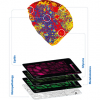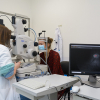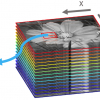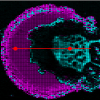Arja M. Kullaa,a,c* Surya P. Singh,a,b Jopi W. Mikkonenb and Arto P. Koistinenb
aInstitute of Dentistry, University of Eastern Finland, Kuopio, Finland. E-mail: [email protected], [email protected]
bSIB labs, University of Eastern Finland, Kuopio, Finland
cDepartment of Diagnostics and Oral Medicine, Institute of Dentistry, University of Oulu, Oulu, Finland
Introduction
Optical spectroscopy (OS) methods hold great promise and may have the potential to change the work flow of cancer management in the near future. These methods are being explored as an alternate or adjunct tool for non-invasive cancer diagnosis. Extensive research aiming towards translation of this technology for routine clinical usage has successfully demonstrated its efficacy in discriminating normal, cancerous and pre-cancerous conditions in different cancers. However, several other areas in the cancer care circle such as surgical boundary identification, optical biopsy and Therapeutic Response Monitoring (TRM) require further improvement.1,2
Providing effective cancer treatment is considered as one of the most challenging burdens on healthcare systems throughout the world. As novel treatment strategies are inclined towards developing individualised patient care, efficient response monitoring could be a critical aspect in cancer management. Currently these are performed using standard-of-care anatomic imaging modalities only after multiple regimens of systemic therapy. A reduction in tumour size is considered as the gold standard for assessing the effectiveness of treatment. Conventional anatomic imaging methods are only suitable for assessing the effect of therapies that result in a change of tumour size. However, several functional changes often precede this morphological variability.3 Optical spectroscopic methods offer non-invasive, portable, fast and low-cost alternatives for effective, early and repetitive monitoring of tumour dynamics at the bedside when therapy is being administered. The introduction of OS techniques into TRM after only one first-line treatment regimen would be revolutionary and could have an enormous impact on cancer treatment, management and survival rates. A wide range of specimens such as tissues, cell lines, animal models and a variety of optical spectroscopic methods have been utilised for TRM in different cancers. The main objective of this short review article is to provide readers with a quick overview of different OS methods used for TRM and their future prospects.
Diffuse optical spectroscopic imaging in TRM
Diffuse optical spectroscopic imaging (DOSI) has been one of the most widely explored optical methods for TRM. In the case of breast tumours, diagnosis by X-ray, mammography, magnetic resonance imaging (MRI) and ultrasound (US) methods can provide accurate lesion localising ability. However, these methods generally lack a capability to provide functional information vital for diagnostic and response monitoring purposes.4 Positron emission tomography (PET) can provide information about metabolic changes but it requires exogenous radiotracers and suffers from low resolution.5 Consequently invasive methods such as fine needle aspiration cytology (FNAC) or multiple biopsies are performed for TRM in breast cancer. DOSI is a non-invasive, functional imaging technique that quantifies the concentration and molecular state of tissue haemoglobin, water and lipids. Measurement of haemoglobin absorption in vivo is one of the central approaches in DOSI.4,6 The absorption spectra of oxy- (O2Hb)and deoxyhaemoglobin (HHb) differ significantly and the ratio between the two states in tissues is highly conserved, see Figure 1.

The changes in oxy- and deoxyhaemoglobin concentration often indicate tissue abnormality and are frequently used to identify physiological problems and follow the effects of therapy.5 This method is responsive to tissue physiology and therefore its performance is not necessarily compromised by structural changes that impact breast density. As shown in Figure 1, a typical set up of a DOSI system consists of a hand-held fibre optic probe in a source detector configuration. Clinical measurements are performed by linearly scanning the probe at consecutive positions across the lesion and repeating the same measurements on the contralateral breast, as illustrated in Figure 1(b). Tromberg’s group at the Beckman Laser Institute, California, USA, has carried out some pioneering work using this technique.7,8,9 In one of these studies, utilising a portable DOSI system, they have shown that DOSI methods are well suited for frequent monitoring of chemotherapy response in a post-menopausal woman undergoing neo-adjuvant chemotherapy for locally advanced breast cancer.9 DOSI measurements were performed over a period of 68 days and the findings suggest a reduction by 56% and 67% in total water and haemoglobin concentration, respectively, by final treatment. Also there was an increase in lipid content by 28%. These findings also suggest the feasibility of predicting tumour response with an accuracy comparable to gold standard surgical methods, by observing changes in haemoglobin and water concentration in the first week of treatment.9 Along similar lines, Cerussi et al. have shown that variation in tumour response with respect to the chemotherapy agent can also be monitored by DOSI. As an alternative to directly comparing tumour water and deoxyhaemoglobin content, they computed tissue optical index defined as ([deoxyhaemoglobin] × [water])/[lipids]) to evaluate treatment response.9 Their findings indicate that the high specificity and sensitivity of DOSI may offer novel opportunities for studying drug mechanisms in patients, and ultimately may serve as a useful tool to developing dosing strategies for individualised patient care.
Raman spectroscopy in TRM
Raman spectroscopy (RS) is an analytical optical spectroscopic technique in which the spectral output consists of characteristic vibrational frequencies, which can provide information about the molecular and biochemical composition of a specimen.1 The instrumental set-up generally consists of a confocal microscope or fibre optic probe coupled with a laser and a detector. Applicability of RS methods in objective and non-invasive cancer diagnosis is well documented. However, it is fairly new in the field of TRM. A few early studies have shown that RS methods can be used for monitoring radiation response.1 Mathews et al. have shown that RS can identify differences between cells treated with different doses of radiation.10 Major changes were observed in the spectra of the proteins, nucleic acids and lipids. A study carried out by Vidyasagar et al. on biopsies has shown that radiotherapy induced changes in cervical cancer patients before and 24 hours after the second fraction of radiation treatment can be identified with high sensitivity and specificity.11 Lakshmi et al. have reported that small changes in the lipid composition and mineral content can be identified with RS in oral cancer patients undergoing radiation treatment.12 Further the same researchers have demonstrated identification of radiation-induced changes in mice brain tissue with RS. They studied radiation-induced changes in brain and muscle tissues and inferred that radio-protective mechanisms work throughout the body irrespective of the site of exposure.13 Gong et al. performed RS investigations to identify radiation-induced changes in the bone biochemistry in a preclinical model. Their findings suggest significant increase in the collagen cross-linking ratios and decrease in the mineral content coupled with irradiation duration, see Figure 2.14

These findings were further verified by another RS study involving a radio-protective agent.15 Various other studies have demonstrated successful application of RS methods in discriminating radiation sensitive and resistant breast, oral and prostate cancer cell lines. Even though RS methods due to minimal water interference are well suited for in vivo application most of the studies with respect to response monitoring have been carried on ex vivo specimens such as tissues, cell lines etc. Efforts have been undertaken for in vivo measurements in some of the easily accessible sites, e.g. oral or breast cancers. In the future with several promising technological advancements this technique has the potential to become an alternate tool for cancer diagnosis and TRM.
Diffuse reflectance and fluorescence spectroscopy in TRM
Tumour oxygenation is a critical factor in determining the effects of radiation and chemotherapy in cancer treatment. Studies have shown that the tissue oxygenation status of tumour-bearing subjects remains hypoxic while that of subjects undergoing treatment increases progressively. OS methods based on diffuse reflectance (DR) and fluorescence offer attractive means of non-invasive monitoring of tissue oxygenation status.3 DR spectroscopy is performed by measuring the diffusely reflected light as a function of wavelength; it is influenced by scattering as well as the concentration of dominant absorbers such as oxygenated and deoxygenated haemoglobin. A typical instrument for clinical measurements consists of a fibre optic probe coupled with a light source and a detector. Fluorescence spectroscopy (FS) involves illuminating (exciting) the tissue at a given wavelength (band) and recording (the fluorescence emission) at longer wavelengths. Autofluorescence is another variant that is sensitive to the fluorescence properties of endogenous chromophores such as tryptophan, collagen, flavin adenine dinucleotide (FAD), nicotinamide adenine dinucleotide (NAD) and other aromatic electron carriers.3 These fluorophores can be identified and quantified on the basis of their excitation and emission properties and this information can be used to develop objective diagnostic tools. Multiple studies involving animal models have been carried out to demonstrate the applicability of these methods in objective monitoring of changes in tumour physiology. Using a fibre optic probe Finlay and Foster successfully monitored changes in haemoglobin saturation by recording DR spectra from murine tumours in response to inhalation of hyperoxic and hypoxic gases.16 Along similar lines, Palmer et al. further demonstrated the use of DR and FS for monitoring tumour oxygenation and metabolism in response to carbogen gas breathing.17 Measurements were performed using a needle-based fibre optic probe and Monte Carlo simulations were used for data analysis. Their results are suggestive of a significant increase in haemoglobin saturation due to gas inhalation. This study was followed by another study, in which a combination of these two techniques was used for multiparametric characterisation of the tissue’s optical properties.18 They monitored changes in the tumour physiology in relation to hyperthermia and treatment with doxorubicin in temperature sensitive liposome. The results indicated an increase in haemoglobin saturation with treatment.18 Spliethoff et al. using dual modality diffuse reflectance-autofluorescence spectroscopy (DR-AFS) have successfully demonstrated that effects of systemic treatment can be monitored in a mouse model for hereditary breast cancer.3 The DR spectroscopy studies suggested significant changes in tissue oxygenation status and fat volume fraction coupled with decrease in tumour volume, see Figure 3. Furthermore, dual-photon excitation microscopy was utilised to measure intrinsic fluorescence to confirm effects of treatment from histological sections, see Figure 3. Even though these results are promising, large scale validation involving both preclinical and clinical studies is required. Also efficacy of these methods in identifying other clinical parameters such as treatment resistance, angiogenesis needs to be evaluated.

Conclusion and future perspectives
The relevance of OS methods in biomedical research has gained the attention of many scientists, engineers and clinicians due to their ability to provide objective functional and molecular information in a short span of time. The diversity in the imaging and spectroscopic platforms as per the clinical requirement is a unique strength of this technology. Most of the work in this field has focused on diagnosis of early invisible lesions, which cannot be diagnosed by the naked eye. Promising results have been obtained, however, slowly it is being realised that these methods may also have potential in monitoring therapy response and individualised patient care.5
Among the above discussed approaches, DOSI methods hold great potential as these are relatively cheap, fast and provide both quantitative and physiologic information. Efficacy of DOSI in TRM has been evaluated extensively under clinical settings in breast cancer subjects. The future developments in this technique should be focused on increasing penetration depth and developing a catheter-based system. Combining DOSI with existing radiological modalities such as ultrasound, MRI and mammography will provide a unique opportunity to explore structural as well as functional parameters associated with therapy response. The Raman spectroscopic technique has been widely explored in the field of radiation oncology. Raman spectra can provide a molecular “fingerprint” of the tissues and cells without any external agent. The results of the multiple in vitro and pre-clinical animal studies undertaken so far have provided a promising outlook for RS-based methods as being effective for response assessment. Technological advances such as designing a complete hardware apparatus which is compact and can be easily integrated into clinical settings is needed for successful translation. Optimising automated and simplified interfaces for data analysis for clinicians or non-experts is also required. Methods based on DR and FS can provide information about blood oxygenation status; these have been tried extensively on animal models. Dual modality methods based on DR-AFS provides quantitative information that can be used to generate predictive models for therapeutic response. An accurate choice of wavelength is important in order to obtain maximum information and the best possible penetration depth. Evaluation of skin interference on the spectral profile is also required for monitoring fast dynamic changes in blood oxygenation.
OS in response monitoring is a relatively new concept, which needs extensive validation under in vitro and pre-clinical set-up. Successful translation of this technology may contribute to fast-response evaluation and timely shifting of systemic treatment. In a time of personalised medicine this could add a great clinical benefit due to its non-invasive nature. Currently in order to generate the best possible personalised treatment plan, repeated tumour core biopsies are performed in order to generate a genetic or epigenetic profile. As OS methods are sensitive to physiological variations, in future as an alternative, an “optical tumour profile” can be generated by performing measurements at different time points in a non-invasive manner from a relatively larger area. This can provide a real-time assessment of physiological changes occurring in tumours and associated microenvironment. In this way, it may help to personalise cancer treatments and may improve cost effectiveness.
References
- S. Devpura, K.N. Barton, S.L. Brown, O. Palyvoda, S. Kalkanis, V.M. Naik, F. Siddiqui, R. Naik and I.J. Chetty, “Vision 20/20: The role of Raman spectroscopy in early stage cancer detection and feasibility for application in radiation therapy response assessment”, Med. Phys. 41, 050901 (2014). doi: http://dx.doi.org/10.1118/1.4870981
- D. Evers, B. Hendriks, G. Lucassen and T. Ruers, “Optical spectroscopy: current advances and future applications in cancer diagnostics and therapy”, Future Oncol. 8, 307 (2012). doi: http://dx.doi.org/10.2217/fon.12.15
- J.W. Spliethoff, D.J. Evers, J.E. Jaspers, B.H. Hendriks, S. Rottenberg and T.J. Ruers, “Monitoring of tumor response to Cisplatin using optical spectroscopy”, Transl. Oncol. 7, 230 (2014). doi: http://dx.doi.org/10.1016/j.tranon.2014.02.009
- N. Shah, A.E. Cerussi, D. Jakubowski, D. Hsiang, J. Butler and B.J. Tromberg, “The role of diffuse optical spectroscopy in the clinical management of breast cancer”, Dis. Markers 19, 95 (2003). doi: http://dx.doi.org/10.1155/2004/460797
- M. Solomon, Y. Liu, M.Y. Berezin and S. Achilefu, “Optical imaging in cancer research: basic principles, tumor detection, and therapeutic monitoring”, Med. Princ. Pract. 20, 397 (2011). doi: http://dx.doi.org/10.1159/000327655
- B.J. Tromberg, A. Cerussi, N. Shah, M. Compton, A. Durkin, D. Hsiang, J. Butler and R. Mehta, “Imaging in breast cancer: Diffuse optics in breast cancer: detecting tumors in pre-menopausal women and monitoring neoadjuvant chemotherapy”, Breast Cancer Res. 7, 279 (2005). doi: http://dx.doi.org/10.1186/bcr1358
- S. Kukreti, A. Cerussi, B.J. Tromberg and E. Gratton, “Intrinsic near-infrared spectroscopic markers of breast tumors”, Dis. Markers 25, 281 (2008). doi: http://dx.doi.org/10.1155/2008/651308
- D.B. Jakubowski, A.E. Cerussi, F. Bevilacqua, N. Shah, D. Hsiang, J. Butler and B.J. Tromberg, “Monitoring neoadjuvant chemotherapy in breast cancer using quantitative diffuse optical spectroscopy: a case study”, J. Biomed. Opt. 9, 230 (2004). doi: http://dx.doi.org/10.1117/1.1629681
- A.E. Cerussi, V.W. Tanamai, R.S. Mehta, D. Hsiang, J. Butler and B.J. Tromberg, “Frequent optical imaging during breast cancer neoadjuvant chemotherapy reveals dynamic tumor physiology in an individual patient”, Acad. Radiol. 17, 1031 (2010). doi: http://dx.doi.org/10.1016/j.acra.2010.05.002
- Q. Matthews, A. Jirasek, J.J. Lum and A.G. Brolo, “Biochemical signatures of in vitro radiation response in human lung, breast and prostate tumour cells observed with Raman spectroscopy”, Phys. Med. Biol. 56, 6839 (2011). doi: http://dx.doi.org/10.1088/0031-9155/56/21/006
- M.S. Vidyasagar, K. Maheedhar, B.M. Vadhiraja, D.J. Fernendes, V.B. Kartha and C.M. Krishna, Biopolymers 89, 530 (2008). doi: http://dx.doi.org/10.1002/bip.20923
- R.J. Lakshmi, M. Alexander, J. Kurien, K.K. Mahato and V.B. Kartha, “Prediction of radiotherapy response in cervix cancer by Raman spectroscopy: A pilot study”, Appl. Spectrosc. 57, 1100 (2003). doi: http://dx.doi.org/10.1366/00037020360695964
- R.J. Lakshmi, V.B. Kartha, C. Murali Krishna, J.G.R. Solomon, G. Ullas and P. Uma Devi, “Tissue Raman spectroscopy for the study of radiation damage: brain irradiation of mice”, Radiat. Res. 157, 175 (2002). doi: http://dx.doi.org/10.1667/0033-7587(2002)157[0175:TRSFTS]2.0.CO;2
- B. Gong, M.E. Oest, K.A. Mann, T.A. Damron and M.D. Morris, “Raman spectroscopy demonstrates prolonged alteration of bone chemical composition following extremity localized irradiation”, Bone 57, 252 (2013). doi: http://dx.doi.org/10.1016/j.bone.2013.08.014
- C.N. Tchanque-Fossuo, B. Gong, B. Poushanchi, A. Donneys, D. Sarhaddi, K.K. Gallagher, S.S. Deshpande, S.A. Goldstein, M.D. Morris and S.R. Buchman, “Raman spectroscopy demonstrates Amifostine induced preservation of bone mineralization patterns in the irradiated murine mandible”, Bone 52, 712 (2013). doi: http://dx.doi.org/10.1016/j.bone.2012.07.029
- J.C. Finlay and T.H. Foster, “Hemoglobin oxygen saturations in phantoms and in vivo from measurements of steady-state diffuse reflectance at a single, short source-detector separation “, Med. Phys. 31, 1949 (2004). doi: http://dx.doi.org/10.1118/1.1760188
- G.M. Palmer, R.J. Viola, T. Schroeder, P.S. Yarmolenko, M.W. Dewhirst and N. Ramanujam, “Quantitative diffuse reflectance and fluorescence spectroscopy: tool to monitor tumor physiology in vivo”, J. Biomed. Opt. 14, 024010 (2009). doi: http://dx.doi.org/10.1117/1.3103586
- G.M. Palmer, R.J. Boruta, B.L. Viglianti, L. Lan, I. Spasojevic and M.W. Dewhirst, “Non-invasive monitoring of intra-tumor drug concentration and therapeutic response using optical spectroscopy”, J. Control. Release 3, 457 (2010). doi: http://dx.doi.org/10.1016/j.jconrel.2009.10.034














